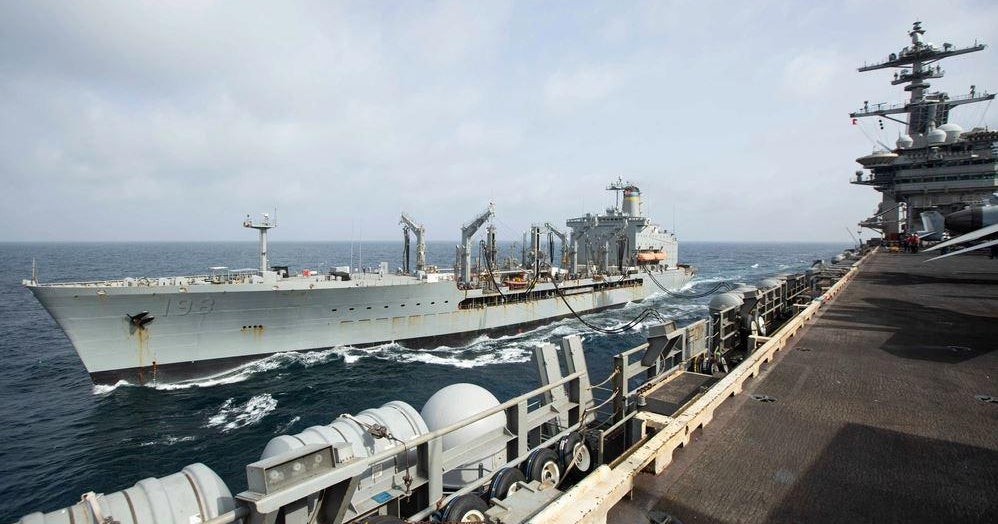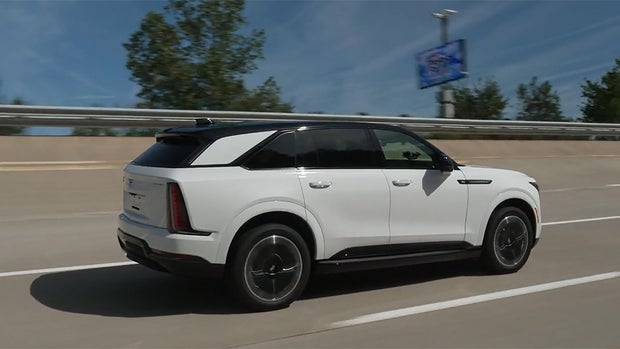CBS News
GM’s CEO on electric vehicles: “This is one of the most exciting times in our industry”

During her ten years as CEO of General Motors, Mary Barra has made big investments in software and driverless cars. At a 2021 trade show, Barra said, “At General Motors our vision for the future is a world with zero crashes, zero emissions, and zero congestion. The key to unlock that vision is electrification.”
But it was her promise three years ago to stop selling gas-powered vehicles by 2035 – and GM’s ability to live up to it – that will likely define her legacy.
Asked if she anticipates GM will be all-electric by 2035, Barra replied, “For our light-duty vehicles, yes. We’ll be guided by the consumer, but the plans that we have in place will get us there.” Nonetheless, in the face of slowing EV sales, Barra said, “I don’t think we ever thought it was gonna be linear.”
CBS News
Wall Street darling Tesla still dominates the market with nearly half of the EVs on the road in the United States. But their market share is shrinking. And with nine all-electric cars and trucks currently available, and four more on the way, GM seems determined to catch up.
“Sunday Morning” was the first to drive GM’s highly-anticipated and soon-to-be-released electric Cadillac Escalade IQ. Starting around $130,000, with a range of at least 460 miles per charge, it includes features like the semi-autonomous Super Cruise, which allows hands-free driving on many roads.
CBS News
For a peak at what else is around the corner, GM invited us for a rare look inside its century-old Milford Proving Ground. A 45-minute drive from the company’s headquarters in Detroit, the Proving Ground has long been a hub for automotive innovation. GM conducted the industry’s first rollover test, and the first crash test using those famous dummies, all right here.
Today, the 4,000-acre site is home to more than 140 miles of every kind of test track imaginable, from off-road to brick road, even an honest-to-goodness race track.
Tony Roma, the executive chief engineer for Corvette, took us for a spin in the new ZR1. With 1,064 hp and a top speed over 200 mph, it’s the fastest Corvette ever. On this day we managed to hit 170.
CBS News
Van Cleave asked, “With all of the computer modeling you guys do now, why is any of this necessary?”
“You still need to stress the components to correlate the models,” Roma replied.
Every detail of the ZR1 is being perfected at Milford, from the handling to that signature Corvette sound. “We put a lot of effort into the sound – the startup sound, the sound when it’s accelerating,” Roma said. “We’ll do 50 or 60 different iterations. It’s like tuning an instrument.”
“On some level, does a Corvette always need to be a gas-powered vehicle?” asked Van Cleave. “Can you have that sound and that feel [with a hybrid]?”
Roma replied, “We talk about this a lot. I talk about this with enthusiasts, my friends, other engineers.”
Last year, GM’s introduction of its hybrid Corvette, the E-Ray, was met with some initial skepticism. But that has not dampened speculation that an all-electric Corvette isn’t far behind, fueled in part by President Biden, who said in 2021, “I have a commitment from Mary. When they make the first electric Corvette, I get to drive it!”
CBS News
According to Roma, “We’re not going to apply electrification just for the sake of it. We don’t put technology on just for technology’s sake. It kind of has to earn its way in, has to make the car better in some way that our customers are going to respond to.”
Most Americans have so far been reluctant to make the switch and plug in. Last year, electric vehicles made up only about eight percent of new car sales; and government subsidies aimed at speeding the transition have become a contentious issue on the campaign trail.
Barra was surprised that EVs have become a political issue: “I never thought the propulsion system on a vehicle would be,” she said. “Again, I think one of the strengths of General Motors is we’re giving people choice. We’re not telling you what you have to have. We’re saying, if you want this, we have it.”
Adoption of EVs is happening fast in other countries, and most analysts believe it will eventually catch up here, leaving Detroit in a lurch if they aren’t ready to compete.
Barra believes the legacy car makers can move fast enough: “I absolutely believe yes, we can, and I think yes, we are,” she said. “Our workforce is quite young. Most of our technical talent has been with the company less than five years – I would say about 40 percent. They’re joining because they want to be part of the company that is going to change and lead in the move to electric vehicles.”
“So, too soon to ask you about your legacy?” asked Van Cleave.
“I think legacy is what someone else writes,” she said. “I hope everybody knows, I love this company, I believe in the team.”
Barra is GM’s second-longest-serving CEO, but she’s showing no sign of slowing down. And for good reason: the future of this iconic American company is riding on whether or not she’s right about the road ahead.
“I think this is one of the most exciting times in our industry,” Barra said. “There’s so much change right now that – for an engineer – it just makes it super-exciting.”
For more info:
Story produced by Mark Hudspeth and Kathryn Krupnik. Editor: Remington Korper.
CBS News
The Secret Behind Temu’s Amazing Bargains Revealed

Watch CBS News
Be the first to know
Get browser notifications for breaking news, live events, and exclusive reporting.
CBS News
Senate report details Secret Service failures in response to Trump assassination attempt in Butler

An interim Senate report identifies planning, communications and security failures in the U.S. Secret Service’s advance and security efforts during former President Donald Trump’s July rally that “directly contributed” to the assassination attempt against him.
The 94-page report, released Wednesday morning, cited nearly half a dozen problems, including lack of a chain of command, poor coordination with state and local law enforcement, inadequate resources and equipment and a failure to effectively secure the site and ensure the safety of the former president at the Butler, Pennsylvania, incident.
The preliminary findings were part of a joint investigation with the Senate Homeland Security and Governmental Affairs Committee and the Permanent Subcommittee on Investigations.
“Every single one of these actions is directly related to a failure in the U.S. Secret Service’s planning, communications, intelligence sharing and law enforcement coordination efforts,” Chairman Gary Peters told reporters Tuesday ahead of the report’s release. “Every single one of those failures was preventable, and the consequences of those failures were dire.”
Gunman Thomas Crooks fired eight rounds with an AR-15 semiautomatic rifle from the roof of an adjacent building before he was killed by a countersniper, grazing Trump’s ear, killing one person at the rally and injuring three others in the July 13 shooting.
The Senate report says several Secret Service officials had chronic problems with their radios. In one instance, a Secret Service countersniper was offered a local radio to help with communications through the day, but he didn’t have time to pick it up because he was working on “fixing” his own Secret Service radio. Due to failures of radios on site in Butler, the special agent in charge gave away his radio to a lead advance agent and went without one for the rest of the day, according to the Senate report.
A text message sent by a Secret Service employee to a supervisor an hour before the shooting warned, “I’m not getting good comms on either my phone or radio. I’ll try to stay on[.]”
At the same time, the Secret Service’s drone units had “technical problems” — so much so, that at 4:33 p.m., the Secret Service employee operating the drone system had to call a toll-free helpline for support. The report notes the agent had only three months of experience working with that equipment and lacked knowledge about it.
The preliminary report also found that Secret Service personnel were notified about a suspicious person with a rangefinder 27 minutes before the shooting, but the lead service agent and other site officials told the panel they did not receive the information.
Another alert about an individual on the roof of a building was sent by radio from a local law enforcement officer to the Secret Service two minutes before the shooting. This was followed by another alert that the individual was armed, but the message was “not relayed” to key Secret Service personnel, the report stated.
“Leaving a roof unattended, just you know, barely over 100 yards from the podium with a direct line of sight was an unacceptable and inexcusable error,” said GOP Kentucky Senator Rand Paul, a ranking member on the committee. “Everybody thought this guy was suspicious and nobody thought to stop the proceeding and remove the former president from the stage.”
A counter sniper who was interviewed by the panel described seeing local law enforcement running toward the building where Crooks was positioned with guns drawn, but he did not alert Trump’s protective detail because it “did not cross [his] mind” to notify someone to get Trump off the stage.
According to the report, counter sniper teams were dispatched to Butler following “credible intelligence” of a threat, marking the first time this type of team was deployed to a protectee besides the president and vice president. However, nearly all the Secret Service personnel that spoke to the committee said they were unaware of the potential threat.
“Why am I hearing about threats on TV,” an agent wrote in a note after the shooting that was included in the report.
Members of the Secret Service advance team were also denied additional resources, according to the report, and “could not identify” who had final decision-making authority for the event.
“It was almost like an ‘Abbott and Costello’ farce with ‘who’s on first’ finger pointing by all of the different actors,” said Connecticut Senator Richard Blunmental, who heads the permanent investigative subcommittee. “It was really truth being stranger than fiction.”
The Secret Service has not commented on the report. Last week the agency issued findings from its own “Mission Assurance Review,” which found multiple communications issues and a lack of “due diligence” by the Secret Service.
Acting Secret Service Director Ronald Rowe testified before the committee in late July, shortly after the panel launched its investigation. So far, it has completed 12 interviews, reviewed approximately 2,800 documents and conducted a site visit in Butler. Additional interviews are expected in the coming weeks, but committee aides won’t say if the probe could expand to the second assassination attempt this month, which took place at Trump’s Florida golf club.
The committee issued several recommendations, including enhancing planning and coordination, communication and expanding intelligence assets and resources. It also suggested designating a “single individual” to approve the agency’s security plans.
“We’ve put a lot of meat on the bones here but we are a long way from getting the information we need,” said GOP Wisconsin Sen. Ron Johnson, ranking member of the investigative subcommittee.
contributed to this report.
CBS News
U.S. Navy Big Horn runs aground off Oman as replenishment vessel supports USS Lincoln strike group

The only U.S. Navy oil replenishment ship serving the USS Abraham Lincoln Carrier Strike Group, deployed in the Middle East in support of Israel amid its ongoing war with Hamas and soaring tension between other Iran-backed groups, ran aground Monday off the coast of Oman. U.S. officials told CBS News national security correspondent Charlie D’Agata the damage to the USNS Big Horn was significant enough to cause the partial flooding of the vessel, and it was being escorted by tugboats into port for a full assessment.
The Big Horn is a type of vessel referred to as an “oiler,” which ferries fuel and other vital supplies to ships and aircraft deployed in a strike group.
There were no reported injuries, no other vessels were directly affected and there were no signs of fuel leaks from the Big Horn, but it was the only Navy oiler immediately available in the region to support the Lincoln and its fleet of battleships, escort vessels and aircraft.
Handout/U.S. Navy
Navy officials would not confirm the authenticity of video posted online this week allegedly showing the ship taking on water. The incident was under investigation.
The Big Horn ran aground after a recent resupply mission, with photos released by the U.S. military showing sailors aboard the Lincoln receiving supplies from the oiler on Sept. 5, while another from Sept. 11 showed the Big Horn alongside the Lincoln.
The Lincoln and its associated Navy vessels have been patrolling the Arabian Sea in support of Israel, and to protect U.S. assets in the region. It has played a role in the joint U.S.-British operation to deter Yemen’s Houthi rebels from targeting commercial and military vessels in the region, including in the vital shipping lanes of the Red Sea. The Houthis, who are backed by Iran like Hamas, call their attacks on shipping a means of supporting the Palestinians amid Israel’s war with Hamas.
Numerous airstrikes carried out by U.S. and British vessels and aircraft in the region against Houthi targets in Yemen have failed to stem the missile attacks on ships.
Though the Lincoln itself is powered by a nuclear reactor, but its strike group has vessels powered by fossil fuel that need to be resupplied at sea. The aircraft aboard the Lincoln also need jet fuel. The Big Horn and other ships like it also provide other supplies.
Handout/U.S. Navy
The U.S. official called the damage to the refueler an inconvenience but said the fleet would continue to be able to operate without it. The strike group’s destroyers can refuel in port and they can transport aviation fuel to the carrier to supply the on-board fighter jets and surveillance aircraft.
Oilers like the Big Horn typically have around 80 civilians and five military personnel on board.
The incident comes amid well documented concern over the availability of resources for the U.S. Navy as it faces expanding global threats, not only with the rising tumult in the Middle East, but as China seeks to assert itself militarily in the disputed waters of the South China Sea and around Taiwan.
Labor shortages in shipyards that have led to backlogs in ship production and maintenance, combined with shifting defense priorities, last-minute design changes and cost overruns have all combined to put the U.S. Navy behind China in the number of ships at its disposal.
Navy shipbuilding is currently in “a terrible state” — the worst in a quarter century, says
Eric Labs, a longtime naval analyst at the Congressional Budget Office, told The Associated Press in August that U.S. Navy shipbuilding was in “a terrible state,” largely due to the labor shortages onshore, adding that he did not “see a fast, easy way to get out of this problem.”
















